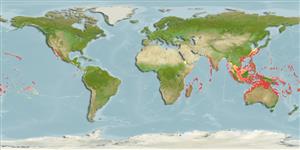Common names from other countries
Environment: milieu / climate zone / depth range / distribution range
Ökologie
seewasser riff-verbunden; tiefenbereich 5 - 132 m (Ref. 89467), usually 6 - 30 m (Ref. 9710). Tropical; 32°N - 32°S
Indo-West Pacific: East Africa to the Hawaiian and Rapa Islands, north to southern Japan, south to Lord Howe Island. Southeast Atlantic: sometimes reaching the southeast coast of South Africa (Ref. 3141).
Size / Gewicht / Alter
Maturity: Lm ? range ? - ? cm
Max length : 23.0 cm TL Männchen/unbestimmt; (Ref. 3141)
Rückenflossenstacheln (insgesamt) : 0; Rückenflossenweichstrahlen (insgesamt) : 9; Afterflossenstacheln: 0; Afterflossenweichstrahlen: 9. Caudal fin rays 10. Strong spine on middle of dorsal ridge.
Inhabit clear outer lagoon and seaward reefs (Ref. 1602). Benthopelagic over rubble and sand at 5-132 m (Ref. 58302). Solitary (Ref. 90102). Males are highly territorial (Ref. 9710). Poisonous in some parts of the tropics (Ref. 7364).
Life cycle and mating behavior
Maturities | Fortpflanzung | Spawnings | Egg(s) | Fecundities | Larven
Myers, R.F., 1991. Micronesian reef fishes. Second Ed. Coral Graphics, Barrigada, Guam. 298 p. (Ref. 1602)
IUCN Rote Liste Status (Ref. 130435)
CITES (Ref. 128078)
Not Evaluated
Bedrohung für Menschen
Venomous
Nutzung durch Menschen
Fischereien: nicht kommerziell; Aquarium: Kommerziell
Tools
Zusatzinformationen
Download XML
Internet Quellen
Estimates based on models
Preferred temperature (Ref.
115969): 24.3 - 28.8, mean 27.5 (based on 776 cells).
Phylogenetic diversity index (Ref.
82804): PD
50 = 0.5625 [Uniqueness, from 0.5 = low to 2.0 = high].
Bayesian length-weight: a=0.03548 (0.01700 - 0.07404), b=2.81 (2.62 - 3.00), in cm Total Length, based on LWR estimates for this (Sub)family-body shape (Ref.
93245).
Trophic level (Ref.
69278): 3.0 ±0.0 se; based on diet studies.
Widerstandsfähigkeit (Ref.
120179): hoch, Verdopplung der Population dauert weniger als 15 Monate. (Fec assumed to be > 10,000).
Fishing Vulnerability (Ref.
59153): Low vulnerability (13 of 100).
